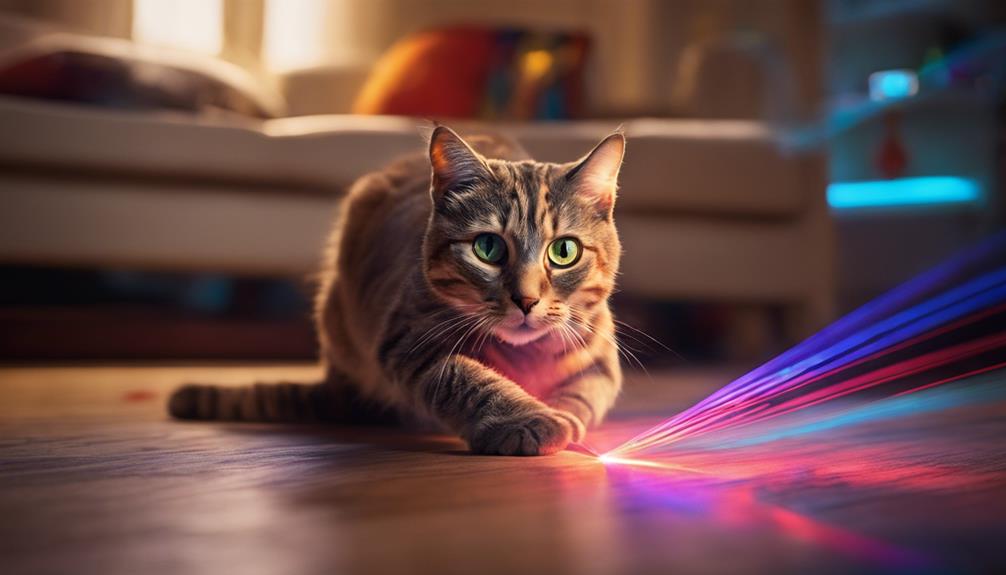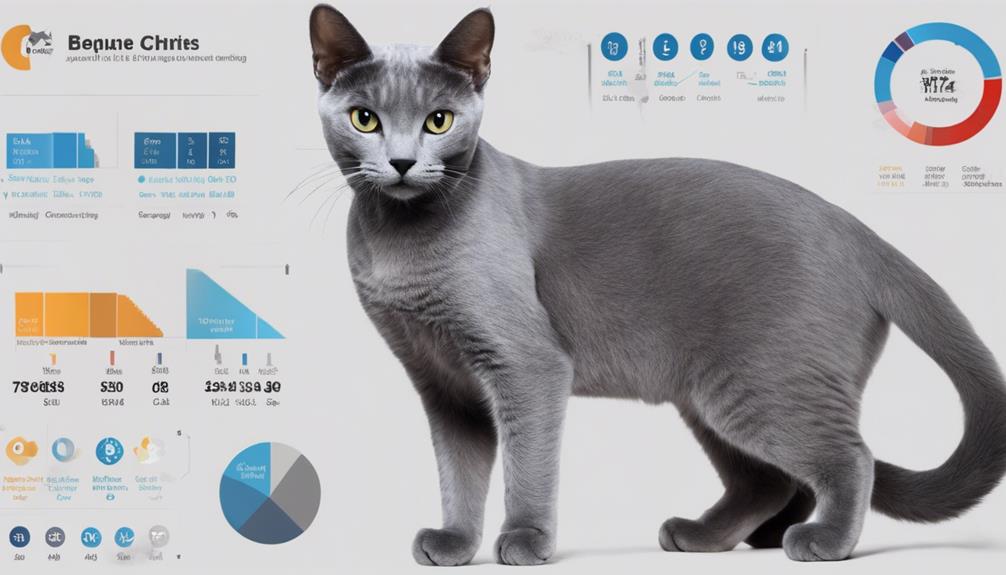When it comes to keeping indoor cats happy and active, the best toys include Interactive Cat Kickers, offering hugging and wrestling fun with catnip; Variety Cat Toy Sets for diverse play; Electronic Interactive Toys for modern playtime and strengthening bonds; Catnip Favorites like Yeowww! Catnip Banana; and Engaging Feather Wands for satisfying hunting instincts. These toys provide mental stimulation, exercise, and entertainment. Your furry friend's playtime will reach new levels with these engaging options.
Key Takeaways
- Interactive cat kickers fulfill natural hunting instincts and promote physical activity indoors.
- Variety toy sets offer diverse play options, stimulating indoor cats for hours of entertainment.
- Electronic interactive toys revolutionize playtime by stimulating hunting instincts safely.
- Catnip favorites like Yeowww! Catnip Banana Toy entice play and add excitement.
- Engaging feather wands are essential for satisfying hunting instincts and promoting exercise and bonding.
Interactive Cat Kickers
Interactive Cat Kickers are a popular choice for engaging indoor cats in active play and exercise. These long, plush toys are designed for cats to hug, kick, and wrestle with, providing a stimulating outlet for their energy.
Filled with catnip, Cat Kickers entice cats to play, keeping them entertained and mentally engaged. Not only do these toys fulfill a cat's natural hunting instincts, but they also promote physical activity, helping indoor cats stay fit and healthy.
The durability of Cat Kickers ensures that they can withstand rough play, making them a safe option for interactive fun. Whether your cat prefers a smaller or larger size, there are various designs to suit different preferences and play styles.
Variety Cat Toy Sets

When looking to provide indoor cats with a diverse range of play options, variety cat toy sets like the Chaser 6-Pack offer a convenient solution. These sets, such as the Taffy Rolls by Hauspanther and Silvervine Sardines by Twin Critters, provide interactive and engaging toys designed to stimulate indoor cats. The Chaser 6-Pack, known for its affordability, is tailored to keep your feline friend entertained for hours on end. Indoor cats thrive on variety and stimulation, making these cat toy sets an excellent choice for their well-being.
Whether it's the crinkle of the Taffy Rolls or the silvervine-infused fun of the Silvervine Sardines, these toy sets cater to your indoor cat's need for engaging playtime. By offering a mix of textures, sounds, and shapes, these sets keep your furry companion mentally and physically active. Investing in variety cat toy sets isn't only beneficial for your cat's health but also adds excitement to their indoor environment, ensuring they lead a happy and fulfilling life.
Electronic Interactive Toys

Have you ever considered how electronic interactive toys can revolutionize playtime for indoor cats? Electronic toys like the Petlinks Mystery Motion Cat Toy and the SmartyKat Hot Pursuit Electronic Motion Cat Toy are designed to tap into felines' instincts to chase and hunt. These toys provide various speed options and mimic real-life prey motions, keeping your cat engaged and entertained for hours. The PetFusion Ambush Interactive Cat Toy and the Frisco Peek-a-Boo Mouse Hunt Cat Toy offer rotating feather toys and peek-a-boo features, stimulating your cat's hunting instincts in a safe and interactive way. If you're looking for a more hands-on approach, the Ethical Pet Laser Exerciser is a compact laser pointer that provides exercise for your indoor cat while strengthening the bond between you and your feline friend. Embrace the world of electronic interactive toys to keep your indoor cat physically and mentally active.
| Electronic Interactive Toys | Description |
|---|---|
| Cat Tracks Butterfly | Mimics real-life prey motion for engaging play |
| Mystery Motion Electronic Motion | Offers multiple speed options to keep cats entertained |
| Hot Pursuit Electronic Motion | Stimulates hunting instincts with different speed settings |
Catnip Favorites

Exploring catnip favorites, we uncover a world of toys infused with nepetalactone, a compound that excites cats and promotes playful behavior.
The Yeowww! Catnip Banana Cat Toy stands out for its clever design, larger size, and being proudly made in the USA.
Cats go wild for the Potaroma Catnip Wall Toy, which can even perk up standoffish felines and encourage delightful licking behavior.
If you're looking for durable and eco-friendly options, the Hepper Catnip Stick Toys are filled with 100% organic catnip and come in beautiful pastel colors that will surely catch your cat's eye.
For a stimulating play experience, consider the Yeowww! Catnip Sardines, a favorite among our feline friends. These catnip toys not only stimulate playful behavior but also provide long-lasting fun.
With so many options infused with organic catnip to choose from, your indoor cat is sure to have a blast with these engaging and durable toys.
Engaging Feather Wands

Feather wands, interactive toys that mimic prey movements, are essential for satisfying cats' hunting instincts and promoting exercise, bonding, and mental stimulation in indoor cats. These toys come in various designs, lengths, and materials, catering to different play preferences. Lightweight and easy to use, feather wands encourage cats to jump, pounce, and chase, keeping them active and engaged.
| Designs | Lengths | Materials |
|---|---|---|
| Bird feathers | 12 inches | Plastic |
| Furry tails | 18 inches | Wood |
| Glittery | 24 inches | String |
Versatile and suitable for cats of all ages and activity levels, engaging feather wands provide a fun way for indoor cats to release energy and stay mentally sharp. Whether your feline friend prefers bird feathers, furry tails, or glittery attachments, there's a feather wand out there to keep them entertained for hours on end.
Frequently Asked Questions
What Is the Best Indoor Entertainment for Cats?
We believe interactive toys like the Petlinks Mystery Motion Cat Toy or catnip toys like the Yeowww! Catnip Banana Cat Toy can provide engaging entertainment for indoor cats. Adding accessory items like the KiTiFISH Feather Accessory enhances playtime.
How Do I Keep My Cat Entertained in the House?
We keep our indoor cats entertained by providing a variety of interactive toys, rotating them regularly to prevent boredom, setting up climbing structures, and using puzzle feeders. These activities engage their hunting instincts and keep them mentally stimulated.
What Cat Toys Do Cats Actually Like?
We love toys that mimic prey movements, like feather wand toys. Interactive toys, such as laser pointers, keep us engaged. Catnip-infused toys are irresistible. Scratching posts cater to our natural instincts. Variety in toys keeps us entertained and mentally stimulated.
How Do You Keep an Indoor Cat Stimulated?
To keep indoor cats stimulated, we engage them with interactive toys, puzzles, and vertical spaces. We rotate toys often and introduce new ones to prevent boredom. Catnip-infused toys, scratching posts, and feeding games are essential for their well-being.
Conclusion
In conclusion, finding the best toys for your indoor cat can bring joy and entertainment to both you and your feline friend.
From interactive kickers to electronic toys, there are plenty of options to keep your cat active and engaged.
So, don't hesitate to spoil your furry companion with some new toys that will provide endless fun and stimulation.
Your cat will thank you with purrs and playful antics that will surely warm your heart.










